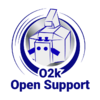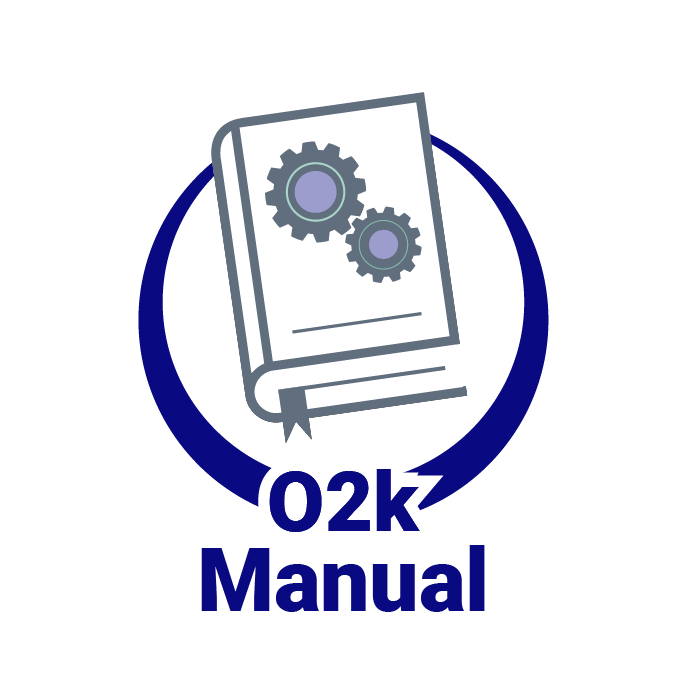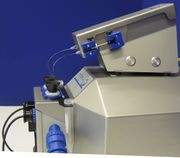From Bioblast
 |
TIP2k-Module |
MitoPedia O2k and high-resolution respirometry:
O2k-Open Support
Description
TIP2k-Module - Titration-Injection microPump (TIP2k) for two-channel operation with the O2k-FluoRespirometer with automatic control by DatLab of programmable titration regimes and feedback control (oxystat, pH-stat).
Reference: Product details and purchase information
Additional resources
O2k-Open Support
- The TIP2k provides unique advantages for applications which require high accuracy of titration volumes and automatic control of complex titration-injection protocols. The TIP2k was specially developed for the O2k. The main modes of operation are automatic multi-step injections, continuous injections for steady-state respirometry, (both operated from the direct control mode), and feedback controlled operation.
- Direct Control Mode: Operation mode for delivering a defined volume in a short pulse. A number of cycles, N, can be defined, and the duration of the interval from injection to injection determined, repeating the process N times. A TIP2k setup with a desired controlled sequential run can be created by programming a series of steps to run in sequence.
- Feedback Control Mode: Operation mode to reach and maintain a certain parameter (e.g., oxygen concentration) by automatic TIP2k injections.
- » TIP2k-Manual - O2k-Manual for using the Titration-Injection microPump and programming TIP2k setups in DatLab.
- The TIP2k is fully supported by the O2k.
- Feedback Control Mode: Operation mode to reach and maintain a certain parameter (e.g., oxygen concentration) by automatic TIP2k injections.
- The TIP2k is placed at the top of the Oroboros O2k. It does not need any extra bench space.
- Align the front legs of the TIP2k with the TIP2k-Spacer Bar on the front of the O2k if you use 200 µl syringes.
- Align the rear ends of the TIP2k and O2k, if you use 500 µl syringes.
- The TIP2k is placed at the top of the Oroboros O2k. It does not need any extra bench space.
TIP2k-Syringes
- For larger volumes,500 µl microsyringes are available.
- » SOP: Handling microsyringes
- Rinse the outside with water immediately after use.
- Wash 3 x with last used solvent, rinse with EtOH (ethanol).
- Storage: EtOH (short), dry (longtime).
- Rinse with pure solvent before use.
- Technical support: TIP2k syringe blocked
Cleaning TIP2k-Syringes
- To prevent washing out effects when the needle is inserted into the O2k-Chamber, the inner diameter of the TIP2k needle has to be very small. This means that the needle is easily blocked by small particles either precipitated from the solution or introduced within the solution.
- While a TIP2k-Syringe has to be considered a consumable, it is possible to lengthen its lifetime by carefully following the procedures suggested in the TIP2k Manual.
- The main way to prevent clogging of needles is to follow rigorously the cleaning procedure after each usage.
- Additionally, it has to be taken care that no particles are suspended in the used solutions.
- For substances with low solubility, filtering the solution may be necessary. Small particles can also be introduced by laboratory activities (e.g., from paper towels or from powdered gloves). Only use powder-free gloves when working with TIP2k syringes!
- Examples of proper TIP2k use and cleaning protocols
- Instrumental O2 background test (dithionite in phosphate buffer or MiR05)
- Clean (fill and empty) the syringe with water.
- Fill the syringe with dithionite solution for washing, discard immediately.
- Fill the syringe with dithionite solution (in buffer) for use during the assay.
- After the assay empty the syringe and immediately wash the outside of the needle with water (because there could be medium sticking to the outside).
- Wash (fill and empty cycles) the syringe three times with water.
- Store the syringe (will be partially filled with water) or after cleaning with ethanol (then it will be partially filled with ethanol.
- CCCP titration (CCCP dissolved in ethanol).
- Clean (fill and empty cycle) the syringe with pure ethanol.
- Clean with CCCP solution (in this case more important than in example 1 because you want to have a precise CCCP concentration).
- Fill with CCCP stock solution and start the experiment.
- After the assay empty the syringe and immediately wash the outside of the needle with water (because there could be medium sticking to the outside)
- Clean (fill and empty cycles) the syringe three times with ethanol.
- Store the syringe (will be partially filled with ethanol) or wash it with water and then store (then it will be partially filled with water).
- Instrumental O2 background test (dithionite in phosphate buffer or MiR05)
Programming the TIP2k in DatLab
Programming the TIP2k for "BG_Feedback"
- In the TIP2k window the modus can be changed by clicking on either direct control or feedback control. In the feedback control several lines can be inserted, all of which take effect during the currently selected line of the main program. In the figure the implementation of program line 1 of the example set up is shown.
- In the main window (Program line), blue highlighting shows that the first program line is selected. The first line in the feedback control window (upper right corner) sets the "start injection" value to 120 mM. The injection is only started when this condition is valid for two consecutive data points (Data N = 2). The interval is set to 200 seconds, which equals the maximum injection time when the maximum volume is set to 100 µl. These parameters are not important for the discussed purpose; however the interval has to be set to at least the (maximum) injection time calculated at the left side. Once an injection is started the program checks the following lines for "stop" instructions. If just one of these conditions is met, the injection will stop. In our example a stop condition is set at 100 µM.
Troubleshooting
TIP2k Volume + Time
- Many thanks to Therkelsen AIb from DK Copenhagen Quistorff B for pointing out this problem.
- Problem: If the user programs an injection by setting volume and time (button "Vol+Time") the required flow is calculated by DatLab. The result is rounded to a precision that can be handled by the TIP2k. For long, slow injections this may result in significantly more or less time being necessary to inject the desired volume than the time entered by the user. If this injection is immediately or with a short delay followed by another injection this may lead to a conflict between the not finished first and the already starting second injection. Using DatLab 4 in this situation will crash the TIP program (error "TIP already running"). In DatLab 6 the program will be executed with the start of the second injection delayed. However the TIP2k status line will behave strangely in the overlapping time and events may be set at the wrong time.
- Suggestions: Use the rounded flow as a starting point to set you own Flow + Volume or Flow + Time values that fit your experimental design.
- Alternative, not tested for all DatLab versions: After entering the desired volume and time, press either the button "Vol+Flow" or "Flow+Time". DatLab will use the rounded flow to calculate a new time, or a new volume, respectively.
Zero oxygen concentration reached but 'Instrumental_O2_background_TIP2k.DLP' is not finished
- - See: O2k open support case
TIP2k errors
- O2k does not recognize the TIP2k
- TIP2k is not responding
- No lights on the TIP2k
- Solutions
- Check if your O2k has the upgrade for the TIP2k. From E-0032 onward all O2ks have an upgrade for the TIP2k. O2k series A-D can be upgraded for TIP2k for an extra fee.
- For O2k Series E onward check if you have connected the TIP2k cable to the plug-in TIP1 on the back of the O2k.
- Solutions
List of publications: TIP2k
MitoPedia methods:
Respirometry,
Fluorometry
MitoPedia O2k and high-resolution respirometry:
O2k hardware,
O2k-Open Support,
O2k-Respirometry,
O2k-FluoRespirometry





